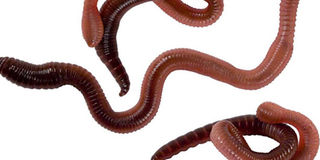How a worm could solve blood donation problems

Harnessing the blood of lugworms due to its extraordinary ability to load up with life-giving oxygen could transform medicine, providing a blood substitute that could save lives. PHOTO| FILE| NATION MEDIA GROUP
The blood of lugworms has the extraordinary ability to load up with life-giving oxygen. Harnessing it for human needs could transform medicine, providing a blood substitute that could save lives, speed up recovery after surgery and help transplant patients.
“The haemoglobin of the lugworm can transport 40 times more oxygen from the lungs to tissues than human haemoglobin,” says Gregory Raymond, a biologist at a fish-farming facility in France. “It also has the advantage of being compatible with all blood types.”
Medical interest in the lugworm — Arenicola marina — dates back to 2003, when the outbreak of mad-cow disease in Europe and the worldwide HIV epidemic began to affect blood supplies. The problem was that animal haemoglobins, as a substitute for the human equivalent, can cause allergic reaction, potentially damaging the kidneys.
BLOOD COULD TACKLE SEPTIC SHOCK
In lugworms, though, haemoglobin dissolves in the blood and is not contained within red blood cells as in humans — in other words, blood type is not an issue — and its structure is almost the same as human haemoglobin.
In 2006, the worm’s potential was validated in a major study. Scientists extracted and purified haemoglobin from lugworms and tested it on lab mice. The rodents were fine and showed no sign of the immune response that dogged other animal substitutes.
If proven safe for humans, the researchers said, the worms’ oxygen-rich blood could tackle septic shock — a crash in blood pressure that can cause fatal multiple organ failure — and help to conserve organs for transplantation.
Clinical trials of the blood product began in 2015. Lugworm haemoglobin was used last year in 10 human kidney transplants at a hospital in the western French city of Brest and 60 patients are currently enrolled in tests of the blood product across France.
The secrets of lugworm haemoglobin lie in its ability to survive in extreme conditions, burrowing into sand at the edges of the tide. The worm grows to about 25 centimetres in length and has several bushy external gills along its body. At high tide, submerged in water, the worm builds up stocks of oxygen that, astonishingly, allow it to survive more than eight hours out of the water at low tide. Anyone who has walked along a sandy beach at low tide will see evidence of lugworms, from the tiny coiled casts of sand they throw up from their burrow, 10 centimetres below the surface. But, apart from anglers who dig up the creatures for bait, lugworms are rarely seen — and breeding them is a novel challenge.
Scientists are excited by the potential of lugworm haemoglobin — although they also point to a rigorous testing procedure before the molecule can be certified as safe and effective for humans.
“The properties of extracellular haemoglobin extracted from the lugworm could help protect skin grafts, promote bone regeneration and lead to universal blood,” says Raymond.
If this vision turns real, lugworm blood may also allow donor organs to live longer outside the bodies, potentially helping thousands of recipients each year.
And, one day, freeze-dried lugworm blood could be a crucial backup for standard blood supplies — a boon in combat zones or disasters.



